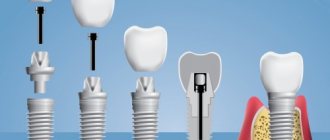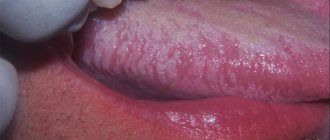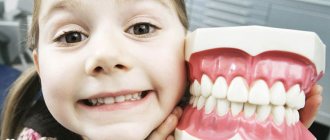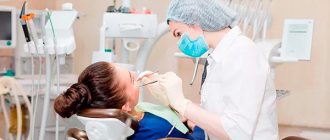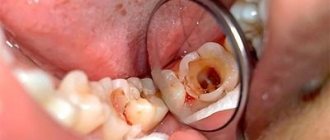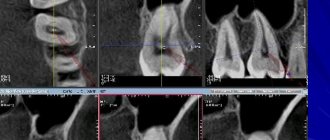Periodontitis
Diabetes
Atherosclerosis
2131 August 26
IMPORTANT!
The information in this section cannot be used for self-diagnosis and self-treatment.
In case of pain or other exacerbation of the disease, diagnostic tests should be prescribed only by the attending physician. To make a diagnosis and properly prescribe treatment, you should contact your doctor. Periodontitis: causes, symptoms, diagnosis and treatment methods.
Periodontitis is a chronic inflammatory disease of the dental system, which is accompanied by the gradual destruction of the tissues surrounding the tooth (periodontal tissue) and a decrease in the volume of the bone tooth socket (alveoli) and the entire alveolar ridge. The name “periodontal disease” is considered outdated, but implies processes similar to periodontitis.
Most often, the disease has a chronic course, accompanied by the appearance of deposits on the teeth, redness and bleeding of the gums, the formation of deep periodontal pockets and pathological mobility of the teeth.
Gradually, this leads to tooth loss in an adult and contributes to the development of pathological processes in the body. Complications of periodontitis can include sinusitis, osteomyelitis, and diseases of the cardiovascular system.
Causes of periodontitis
Periodontitis is a multifactorial disease, meaning it can occur for many reasons. Acute periodontitis (periodontitis) is less common than chronic and is most often the result of mechanical or chemical trauma to the periodontal junction. An abscess (ulcer) appears on the gum, which can lead to the appearance of a fistula (a canal connecting the abscess cavity with the external environment).
Chronic periodontitis often develops as a result of poor oral hygiene, when the activity of oral microorganisms increases.
Soft and hard deposits on teeth are a biofilm, which also includes pathogenic bacteria. Their activity can lead to inflammation of the gums (gingivitis), periodontium (tissues surrounding the root of the tooth) and alveolar bone tissue. The inflammatory reaction leads to the gradual destruction of the ligamentous apparatus of the teeth. The necks of the teeth become exposed, and the teeth gradually become loose and fall out.
Local factors causing the occurrence of periodontitis include overload of the periodontium due to malocclusion due to crowding of teeth, poor prosthetics or loss of a group of teeth. The habit of clenching your jaw tightly and grinding your teeth also leads to overload and inflammation of the periodontium.
The development of periodontitis can be caused by a narrowing of the lumen of blood vessels due to diabetes mellitus, atherosclerosis, changes in the composition of saliva, and tissue swelling that occurs due to endocrine disorders.
In addition, the role of vitamin deficiency in periodontal diseases has been proven. Thus, hypovitaminosis C leads to fragility of blood vessels, decreased collagen synthesis, which weakens the ligaments of the teeth, and a general weakening of the immune system.
Classification of periodontitis
Depending on the clinical symptoms and speed of development of the disease, periodontitis is divided into acute and chronic. An acute process, accompanied by pain and bleeding of the gums, develops within a few days after physical or chemical trauma, most often soon after the placement of a filling, crown or other orthodontic structure. If left untreated, acute periodontitis can be complicated by a fistula. However, in most cases, the acute process is replaced by a chronic one, which can last for several years. In this case, the period of attenuation of clinical symptoms due to provoking factors is replaced by a relapse.
In most cases, the disease becomes chronic from the very beginning. This is facilitated by poor oral hygiene and the formation of soft and hard deposits on the teeth. Chronic periodontitis begins gradually and spreads to the entire surface of the gums, then it is called generalized.
If bleeding gums are observed periodically and are caused by brushing teeth and eating hard foods, a diagnosis of mild periodontitis is made.
With increased bleeding, pain, loosening and loss of teeth, moderate and severe degrees of generalized periodontitis are noted.
Symptoms of periodontitis
In acute periodontitis, pain, swelling and bleeding of the gums develop within a few days after exposure to a traumatic factor. As a rule, pain occurs not only when biting, but also outside of chewing load. It is possible for an abscess to form in the area of the “causal” tooth, which breaks through to form a fistula. If the traumatic factor is not eliminated (remove the crown, remove excess filling), the fistula can become a permanent outlet for pus accumulated in the gingival abscess.
Symptoms of chronic periodontitis develop gradually.
However, over time, mild pain when brushing teeth and chewing becomes commonplace. Bleeding becomes constant, the gums change color, and the necks of the teeth become exposed. The periodontal pockets, which can be measured with a dental probe, deepen. There is an unpleasant odor from the mouth, a burning sensation, pain in the gums and jaws, which intensifies when the teeth are closed. Painful pustules may form under swollen gums. Eating becomes difficult. Gradually, the necks of the teeth are exposed, the bone sockets in which the teeth are attached are reabsorbed, then the teeth become loose and easily fall out.
Diagnosis of periodontitis
First of all, a clinical blood test and a biochemical blood test are needed to assess metabolic processes (total protein, protein fractions, C-reactive protein, ALT, AST, LDH, creatinine, electrolytes: potassium, sodium, chlorine, calcium) and urine for differential diagnosis with inflammatory processes caused by blood diseases (leukemia, agronulocytosis, aplastic anemia, thrombocytopenic purpura) or various diseases of internal organs (including endocrine ones - diabetes mellitus, dysfunction of the liver and kidneys, etc.).
What is localized periodontitis?
Localized, or focal, periodontitis is an inflammation of the periodontal tissues surrounding the tooth. Unlike generalized periodontitis, localized periodontitis spreads locally - it affects only one or several adjacent teeth. And even with prolonged development, the disease does not affect the “neighbors”. The disease affects all age groups, regardless of gender, but people aged 30 to 50 years and adolescents are more likely to suffer.
Acute periodontitis
This phase of the disease develops either with an exacerbation of chronic periodontitis, or when infection penetrates into the periodontal pockets as a result of trauma. Teeth and gums are injured as a result of blows and bruises due to unprofessional dental intervention. Bruxism, a disease in which involuntary grinding of teeth against each other, deserves special attention when considering traumatic factors. Scientists from Okayama University conducted a study according to which most of the observed patients had varying degrees of severity of periodontitis.
There are two main subtypes of acute periodontitis: non-purulent and purulent forms. In the first case, extensive periodontal damage occurs, characterized by severe swelling of the gums, pronounced pain, a significant increase in the spaces between the teeth and gums, progressive destruction of connective tissue, exposed teeth and bleeding. The purulent form is characterized by the formation of fistulas and boils, from which, when pressed, a viscous grayish-white liquid is released, which has a characteristic unpleasant odor. It is localized in a specific area of the oral cavity, without affecting the entire gum.
Acute periodontitis is especially dangerous during pregnancy. Hormonal changes in a woman’s body provoke complications of the disease. If pus and bacteria enter the circulatory system, they can cause fetal toxicity. This can lead to congenital diseases or miscarriage in the child.
Acute periodontitis, like chronic periodontitis, can develop against the background of damage to the body by viruses. Occurring suddenly, it deprives a person of the ability to effectively brush his teeth. If you do not contact a dental clinic as soon as possible, there is a risk of a significant increase in body temperature and poisoning of the body with toxins.
Often the acute form of periodontitis requires surgical intervention. This may include removing a section of gum using a laser or scalpel under local anesthesia (gingivectomy), dissecting the gum and cleaning out the root of the tooth, opening boils and removing pus using a drainage tube.
Diagnostics
To make a correct diagnosis, the doctor first examines the oral cavity and collects anamnesis: listens to the patient’s complaints, identifies symptoms and the time of the first signs of the disease. Then he takes pictures of the tooth and jaw using X-rays and a CT scanner. A mandatory stage in the diagnosis of localized periodontitis is an analysis of blood, urine and microflora of oral tissues to identify disorders in the body and possible causes of pathology.
The disease can be successfully treated in the early stages; you just need to visit a specialist in time. In severe cases, the degree of tooth loosening is so great that only the gum tissue can be cured, and the teeth have to be removed. In this case, the patient is offered implantation or prosthetics.
Treatment methods
The treatment regimen and effectiveness depend on the severity of the pathological process. First, measures are taken to improve the condition of the gums themselves. For this purpose, local therapy is carried out, which includes:
- curettage or ultrasonic teeth cleaning. The procedure is necessary to remove tartar - supra- and subgingival. Ultrasound can also polish tooth enamel, which helps prevent future tartar formation;
- use of local antibacterial drugs. They come in a variety of gels that help suppress the development of bacteria in periodontal pockets. Examples of such drugs: Apident Active, Metrogyl Dent, Adepta;
- the use of anesthetic gels, such as Kamistad, Mundizal. They help get rid of sore gums;
- rinsing the mouth and washing periodontal pockets with antiseptic solutions such as Chlorhexidine and Miramistin;
- the use of special toothpastes with anti-inflammatory properties. They complement the main treatment prescribed by the doctor. Experts often recommend pastes such as Parodontax, Splat Active, Elmex Sensitive, Asepta.
Local anti-inflammatory therapy lasts for at least 10 days. Treatment is carried out twice a day: morning and evening. In parallel with the removal of tartar, caries is treated and non-viable teeth are removed. Even at the stage of drawing up a treatment plan, a decision may be made about the need for prosthetics. In this case, doctors prepare for this process, including tooth removal.
Sanitation of periodontal pockets can also be carried out using laser treatment. The laser is directed deep into the gums, which allows you to destroy pathogenic microorganisms, prevent bleeding and sterilize the oral cavity. This technique also stimulates recovery processes.
The general strengthening treatment regimen also includes various types of physiotherapy:
- balneotherapy,
- phototherapy,
- peloidotherapy,
- gum massage,
- UHF therapy,
- darsonvalization,
- electrophoresis,
- diathermocoagulation.
Preventive measures
To prevent the development of localized periodontitis, the following measures are recommended:
- choose the right toothbrush, toothpaste and mouthwash, maintain oral hygiene and floss after meals;
- create a correct and balanced menu, take vitamins;
- exercise to strengthen your immune system;
- undergo a preventive examination at the dentist every six months, and if symptoms of the disease occur, consult a doctor in a timely manner. Do not trigger any pathologies and disorders in the body;
- try to reduce your stress level - distract yourself with walks, massages and other pleasant and useful rest.
These measures will help prevent the development of not only dental, but also other diseases that affect the condition of the oral cavity.
Treatment of localized periodontitis
First, the patient's dental plaque is removed to eliminate pathogenic bacteria in the oral cavity. The main therapy is focused on the healing of periodontal tissue, gums and treatment of the cause of the disease: vitamins, antiseptics, anti-inflammatory drugs and agents to enhance immunity are prescribed. The patient is referred for examination to an immunologist, endocrinologist and gastroenterologist to prescribe concomitant therapy.
In mild and moderate stages of pathology, curettage is performed - treating gum pockets with antiseptic agents and removing deposits. The teeth are ground and tightened with a special dental splint - the loosening is stopped, and after treatment of the periodontal tissue, the teeth are again securely held in the gums.
Surgical intervention is required only in severe cases of the disease, when the depth of the periodontal pockets is more than 5 mm: excess tissue is excised and sutured. Severe mobility of teeth with exposed roots cannot be treated, and teeth must be removed.
Traditional methods without general drug therapy and dental supervision are taboo. They can alleviate the patient’s condition, but when treating even a mild stage of periodontitis only with traditional methods, the disease will very soon develop into a severe form.
However, as an addition to dental treatment you can use:
- decoctions of oak bark and nettle - for bleeding gums;
- fir and sea buckthorn oil - for severe burning and swelling of the gum tissue;
- a decoction of mint, calendula, violet - for bad breath.
Types of Localized Periodontitis
By severity:
- localized periodontitis of mild severity is characterized by pain in some teeth when pressing on the gums, sometimes bleeding and the appearance of periodontal pockets, but the patient’s general well-being does not change;
- localized periodontitis of moderate severity is determined by deepening of the gum pockets, poor tooth mobility, and regular bleeding of the gums;
- localized periodontitis in a severe stage leads to complete loosening of the teeth, exposure of the roots and suppuration of the gums; the bone is so destroyed that implantation without prior extension is no longer possible.
According to the nature of the pathology:
- acute localized periodontitis develops quickly and rapidly, with the manifestation of all the characteristic symptoms - the disease is successfully treated, but without dental care it becomes chronic;
- localized chronic periodontitis is characterized by moments of exacerbation and calm; it seems to the patient that the pathology has receded, but the inflammatory process continues to destroy tissue and manifests itself in a severe stage.
Causes of localized periodontitis
There are common factors that provoke periodontitis of any form:
- crowded teeth, malocclusion
- infectious diseases of the oral cavity, such as stomatitis
- advanced caries
- smoking
- poor oral hygiene
- vitamin deficiency, diabetes mellitus and gastrointestinal disorders
The causes of localized periodontitis that influence the development of this particular type of disease are: mechanical and chemical damage to the teeth and gums, incorrectly placed fillings, dentures; bruxism.


